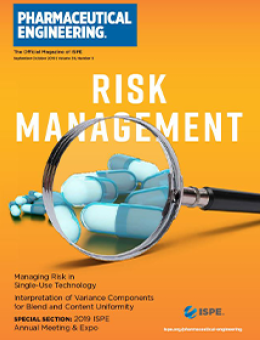Risk management is pervasive throughout the biopharmaceutical industry. It is an important factor during the implementation of new equipment or procedures into an operation. Likewise, risk management is also key when assessing the impact of changes. When doing a root cause analysis, evaluation of the risks becomes central to define the potential solutions to the problem analyzed and to...

Downloads
Risk Management in Single Use Technology
Cover: Risk management is pervasive throughout the biopharmaceutical industry. It is an important factor during the implementation of new equipment or procedures into an operation. Likewise, risk management is also key when assessing the impact of changes. When doing a root cause analysis, evaluation of the risks becomes central to define the potential solutions to the problem analyzed and to eliminate the contributing cause. This article expands on a chapter addressing risk management in single-use technology in the ISPE Good Practice Guide: Single-Use Technology.
Accelerated Pharmaceutical Product Development, Registration, Commercialization, and Life Cycle CMC Lessons, Part 2
Feature: This two-part series focuses on challenges that chemistry, manufacturing, and control (CMC) development teams may encounter when a project is given accelerated development status. In this issue, Part 2 expands the discussion of considerations and themes introduced in Part 1 and presents several case studies of pharmaceutical products being approved using accelerated programs.
Patient-Centric Specification: Regulatory and Industry Progress
Feature: A plenary session entitled ”Patient-Centric Specification” (PCS) was held at the 2018 ISPE Quality Manufacturing Conference in Arlington, Virginia, to discuss the recent regulatory and industry progress on this topic. Attendees discussed the opportunities, challenges, and future directions for establishing PCSs.
2019 ISPE Annual Meeting & Expo
Special Section: This special section looks at what’s coming up at the 2019 ISPE Annual Meeting. It also features the voices of first-year Travel Grant recipients who attended last year’s Annual Meeting courtesy of the ISPE Foundation and offers a look at the 2019 Facility of the Year Award (FOYA) category winners and honorable mentions.
In This Issue
This article is Part 2 of a two-part series exploring what we can learn from examples of pharmaceutical products being approved using accelerated programs. The series focuses on challenges that chemistry, manufacturing, and control (CMC) development teams may encounter when a project is given accelerated development status. In
On 5 June 2018, a plenary session entitled ”Patient-Centric Specification” (PCS) was held at the 2018 ISPE Quality Manufacturing Conference in Arlington, Virginia. More than 160 professionals from...
Despite introducing modern analytical technology to assess blend uniformity, many companies are still using traditional blend sampling thieves and wet chemistry to assess blend homogeneity. The use of statistically based sampling plans allows variance component analysis to be conducted on both blend and dosage unit data. This article shows how various combinations of blend and dosage unit...
Newer container closure integrity (CCI) test methods are more accurate and reliable than longtime industry standards. Transitioning to include deterministic testing alongside probabilistic methods may seem daunting at first, but it is in the industry’s best interest.
As I write my last Chairman column for Pharmaceutical Engineering, I reflect on what has happened over the past year globally and within ISPE. The pace of change in the industry has accelerated and will continue to accelerate with new technologies and business models being deployed.
In a world dominated by social media and online profiles, the art of getting to know someone has been transformed. So, in this age, when you can connect with someone by “swiping right” on a dating app, how do you build a professional network? Face-to-face interactions remain a great starting point. Therefore, whenever I attend a conference or other professional event, I make sure that I am...
In his 17 years as a member of the ISPE United Kingdom Affiliate, Jon Youles has worn many hats, including Editor for the newsletter, Chair of the Southern region’s committee, and Secretary and Vice Chair of the Affiliate. Now, as Chair of the Affiliate, he leads an engaged membership that is thriving even as the...
The 2019 ISPE Annual Meeting & Expo will be held 27–30 October in Las Vegas, Nevada. The theme is “Modernize. Globalize. Transform.” Michael L. Rutherford, Program Committee Chair and Board Ambassador for...
This special section looks at what’s coming up at the 2019 ISPE Annual Meeting. It also features the voices of first-year Travel Grant recipients who attended last year’s Annual Meeting courtesy of the
The second day of the 2019 ISPE Biopharmaceutical Manufacturing Conference in Boston, 18–20 June, kicked off with the Women in Pharma® Balance for Better in Biopharmaceutical Manufacturing...
ISPE will introduce a new platform this fall for online Communities of Practice (CoPs) that will make the Communities of Practices more useful and user-friendly. Participating in a Communities of Practice by posting a...














